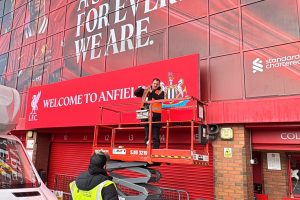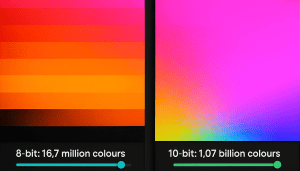Beyond Static: How BMS Occupancy Data Powers Truly Dynamic LED Displays in Retail & Corporate Spaces
In today’s fast-paced world, capturing attention and delivering relevant information is paramount. Traditional digital signage, while a step up from static posters, often presents a one-size-fits-all message. But what if your LED displays could intelligently adapt their content in real-time, responding directly to the people and activity within your space? This is no longer a futuristic concept; it’s a reality powered by integrating your Building Management System (BMS) with sophisticated LED display technology.
Leveraging occupancy data from your BMS is a game-changer, transforming LED screens from passive displays into active, responsive communication tools. For corporate and retail environments, this opens up a wealth of opportunities to enhance experiences, improve efficiency, and drive engagement.
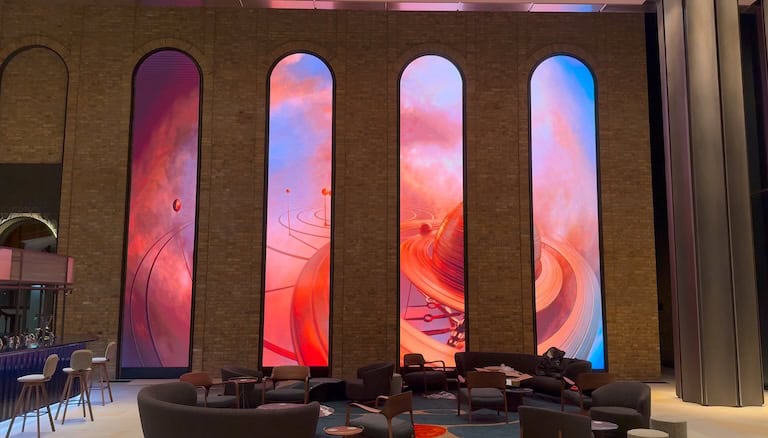
What is BMS Occupancy Data and Why Does It Matter for Displays?
A Building Management System (BMS) is the central nervous system of a modern building, controlling and monitoring various systems like HVAC, lighting, security, and energy usage. Increasingly, these systems incorporate sensors that gather occupancy data – information about how many people are in a specific area, whether a room is in use, or the general flow of foot traffic.
Types of occupancy data a BMS can provide include:
- Presence Detection: Simple binary data indicating if a space (e.g., a meeting room, a specific zone) is occupied or vacant.
- Footfall Counts: The number of people passing through an area or entering a zone over a period.
- Density Levels: An assessment of how crowded a particular area is (e.g., low, medium, high).
- Dwell Time: How long individuals spend in a specific location (though this is sometimes captured by more specialised analytics systems that can integrate with a BMS).
Why does this data matter for your LED displays? Because it provides context. By linking this real-time occupancy information to your LED display’s Content Management System (CMS), messages can become incredibly timely and relevant. Instead of generic announcements, you can deliver targeted information that resonates with the current state of your environment. As noted by sources like Enlighted Inc., BMS platforms are increasingly offering APIs to make data like occupancy and utilisation accessible to other systems, paving the way for such integrations.
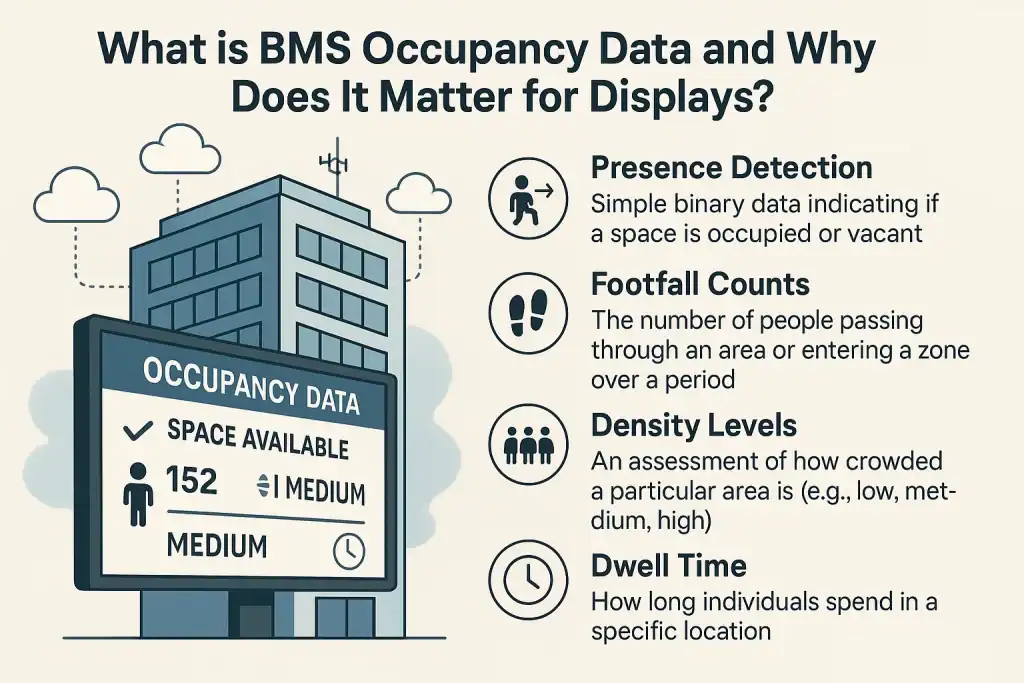
How It Works: Connecting BMS Data to Dynamic LED Display Content
The magic happens when these distinct systems are orchestrated to communicate and act in unison. Here’s a simplified overview of the process:
- Data Source – BMS & Occupancy Sensors:
Your BMS, equipped with various sensors (PIR, ultrasonic, camera-based, etc.), collects raw occupancy data. This could be anything from a simple “room occupied” signal to more detailed footfall counts in different zones.
- Integration Layer – The Crucial Connection:
- APIs (Application Programming Interfaces): This is the most common and robust method. The BMS exposes its data via an API, and the LED display’s CMS uses this API to “listen” for specific occupancy triggers. Companies like XY Sense are already providing APIs for their occupancy intelligence platforms, enabling integration with workplace experience platforms which can, in turn, feed data to digital screens, as highlighted by Sixteen-Nine.
- Middleware/Custom Scripts: In some cases, a small software intermediary or custom script might be needed to translate data between the BMS and the CMS if direct API compatibility isn’t available.
- CMS Capability: Critically, your LED display’s Content Management System must be designed to accept external data triggers and dynamically change content based on predefined rules.
- Triggering Logic – The “If-Then” Scenario:
This is where you define the rules. For example:
- IF
MeetingRoomSensor = OccupiedTHENDisplay_MeetingRoomScreen = "Meeting in Progress - Finance Review" - IF
RetailZoneA_Footfall > 50THENDisplay_NearbyScreen = "Special Offer: 20% off in Home Goods!" - IF
CafeteriaOccupancy = HighTHENDisplay_LobbyScreen = "Cafeteria is busy. Consider visiting after 1 PM."
This data flow, from sensor to BMS to CMS to the LED display, allows for automated, intelligent content changes without manual intervention.
(Imagine a simple flowchart here: Occupancy Sensor -> BMS -> API -> LED Display CMS -> Dynamic Content on LED Screen)
Unlocking Value in Retail: Use Cases & Benefits
For retailers, the ability to adapt messaging based on real-time customer presence is invaluable. It moves displays from being mere decoration to active sales and experience enhancement tools.
- Dynamic Promotions & Advertising:
- Targeted Offers: Trigger advertisements for specific products when footfall in that department or aisle is high. If more customers are browsing electronics, nearby screens can flash deals on the latest gadgets.
- Responsive Pricing/Messaging: Change promotional messaging based on overall store traffic. During quieter periods, screens could display “Beat the Rush” offers or highlight services like personal shopping.
- Increased Sales: Retailers using dynamic digital signage have reported significant sales increases, with some sources like Wallboard.us suggesting figures around 30-33%.
- Enhanced Customer Flow & Experience:
- Real-time Wait Times: Display current waiting times for checkouts, fitting rooms, or customer service desks, helping manage expectations and reduce perceived wait times (which can be cut by up to 35% according to ScreenCloud statistics).
- Wayfinding: Guide shoppers to less congested areas of the store or highlight alternative checkout points during peak times.
- Improved Engagement: Dynamic, relevant content is more likely to capture attention and influence purchasing decisions, with some studies indicating that 70% of customers state digital signage influences their buying choices (CUInsight).
- Optimised Store Operations:
- Staff Alerts: Back-office displays can alert staff to busy zones needing assistance or restocking, triggered by high footfall data.
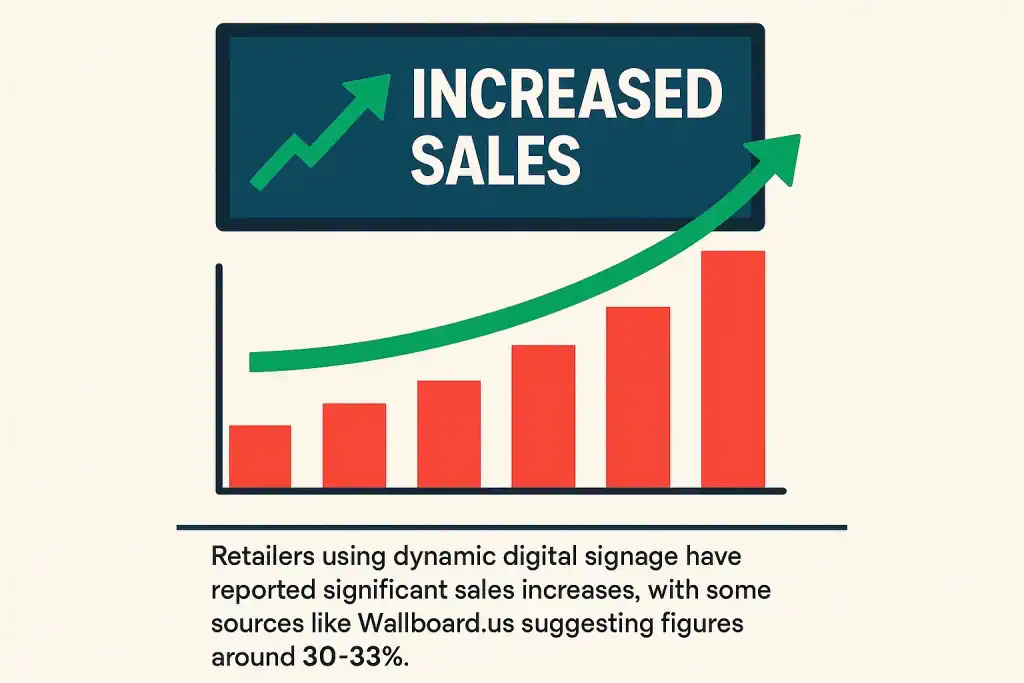
Transforming Corporate Environments: BMS Data Use Cases & Benefits
In corporate settings, BMS-driven dynamic LED displays can streamline operations, improve communication, and create a more intelligent and responsive workplace.
- Intelligent Meeting Spaces:
- Automated Room Status: Displays outside meeting rooms can automatically show “Available,” “Meeting in Progress [Topic/Host],” or upcoming bookings based on actual occupancy detection, eliminating ghost bookings or confusion. Navori highlights the effectiveness of such meeting room occupancy screens.
- Welcome Messages: Personalised welcome messages can be displayed when a scheduled meeting’s participants enter the room.
- Efficient Workplace Navigation & Communication:
- Dynamic Wayfinding: In large office complexes, LED displays can guide employees and visitors, with routes potentially adapting based on highly trafficked or temporarily restricted areas.
- Targeted Internal Comms: Display important announcements, safety alerts, or company news on screens in occupied common areas, canteens, or specific departments, ensuring messages reach active audiences.
- Cafeteria & Amenities Info: Show real-time occupancy levels in the company cafeteria, gym, or other shared spaces. Displays can also showcase daily menus or specials, perhaps changing based on the time of day or how busy the area is.
- Optimised Resource Usage:
- Hot-Desking Availability: Provide live updates on available hot desks or collaborative spaces, helping employees quickly find a place to work.
- Energy Savings: While not direct content, linking display activity (e.g., brightness levels or on/off status) to area occupancy can contribute to overall energy efficiency goals.
Key Considerations for Implementation
Successfully implementing a system where BMS occupancy data drives LED content requires careful planning:
- Choosing the Right Technology:
- BMS: Ensure your BMS can provide accessible and reliable occupancy data, ideally via a well-documented API.
- Sensors: Select appropriate sensor technology for the accuracy and type of data you need.
- LED Display & CMS: Opt for high-quality LED displays and, crucially, a robust Content Management System that explicitly supports integration with external data sources and offers flexible rule-based content triggering. Dynamo LED Displays specialises in providing such integrated solutions.
- Content Strategy for a Dynamic World:
- Plan Variations: Develop multiple content variations for different occupancy scenarios. What should the screen show when an area is empty, moderately busy, or very crowded?
- Clarity & Conciseness: Dynamic messages are often glanced at quickly. They must be clear, concise, and immediately understandable.
- Context is King: Ensure the triggered content is highly relevant to the specific location and the occupancy state.
- Data Privacy & Security:
- Be mindful of data privacy regulations. Occupancy data is generally anonymised, but transparency about data collection and usage is important, especially if camera-based sensors are used.
- Secure the integration points between systems to prevent unauthorised access or manipulation.
- Scalability & Future-Proofing:
- Consider how the system might need to expand. Will you add more displays, integrate more data sources, or develop more complex triggering rules in the future? Choose platforms that can grow with your needs.
The Future is Adaptive: BMS Trends to Watch
The integration of occupancy data with digital displays is just the beginning. Future advancements are likely to include:
- AI-Driven Predictive Content: Machine learning algorithms could analyse historical occupancy patterns to predict future states and proactively adjust content.
- Deeper IoT Integration: Displays could react to a wider array of data from other smart building IoT devices, such as environmental sensors (temperature, air quality) or security systems.
- Sophisticated Analytics: Enhanced analytics will provide deeper insights into how different dynamic content impacts viewer behaviour and occupancy patterns, allowing for continuous optimisation.
Making Your Displays Work Smarter with Occupancy Data
Leveraging the occupancy data already being collected by your Building Management System transforms your LED displays from static fixtures into intelligent, responsive assets. This integration allows for hyper-relevant messaging that can significantly enhance customer and employee experiences, improve operational efficiency, and drive engagement.
By moving beyond generic content, businesses can unlock new levels of communication effectiveness. The ability to automatically adjust what’s shown on screen based on real-time presence and footfall ensures that your messages are not just seen, but are also timely and impactful.
Explore how Dynamo LED Displays can help you integrate BMS data with cutting-edge LED display solutions to make your spaces smarter and your communications more dynamic.
—
Frequently Asked Questions (FAQs)
Q1: What kind of LED displays are best for dynamic content driven by occupancy data?
Any high-quality LED display can show dynamic content. The key is the Content Management System (CMS) behind it. The CMS must be capable of integrating with external data sources like a BMS and triggering content changes based on predefined rules. Dynamo LED Displays offers a range of indoor, outdoor, and custom LED solutions compatible with advanced CMS software.
Q2: Is it complicated to integrate a BMS with an LED display system?
The complexity can vary. If both the BMS and the LED display’s CMS have robust APIs and are designed for integration, the process can be relatively straightforward, often managed by technical teams or integration specialists. In other cases, middleware or custom development might be needed. It’s important to discuss integration capabilities with your BMS provider and LED display supplier.
Q3: What are the primary benefits of using BMS occupancy data for LED displays over other data sources?
BMS occupancy data is often already being collected for building efficiency and management. Utilising this existing data stream for display content is a cost-effective way to add significant intelligence. It provides a direct, real-time reflection of how physical spaces are being used, which is highly relevant for contextual messaging in retail and corporate environments.
Q4: How does dynamic content based on occupancy affect ROI for digital signage?
By making content more relevant and timely, dynamic displays can significantly boost engagement, influence purchasing decisions in retail (potentially increasing sales by up to 30-33% as suggested by some studies like those on Wallboard.us), and improve information dissemination and space utilisation in corporate settings. This increased effectiveness and efficiency contribute to a stronger ROI compared to static or non-data-driven digital signage.
Q5: Can this system work for outdoor LED displays?
Yes, absolutely. For example, outdoor displays at retail parks could show dynamic directions to less crowded parking areas based on occupancy data, or event venues could manage queue information on large outdoor screens. The principles of data integration and content triggering remain the same, provided the outdoor LED display system supports such dynamic capabilities.
Q6: What about data privacy with occupancy sensors?
Most occupancy sensors used with BMS systems (like PIR or thermal sensors) collect anonymous data (i.e., they detect presence or count, not individuals’ identities). If camera-based sensors are used for more advanced analytics, it’s crucial to adhere to privacy regulations like GDPR, ensure data is anonymised or aggregated, and be transparent about data collection. Responsible data handling is a key consideration.



